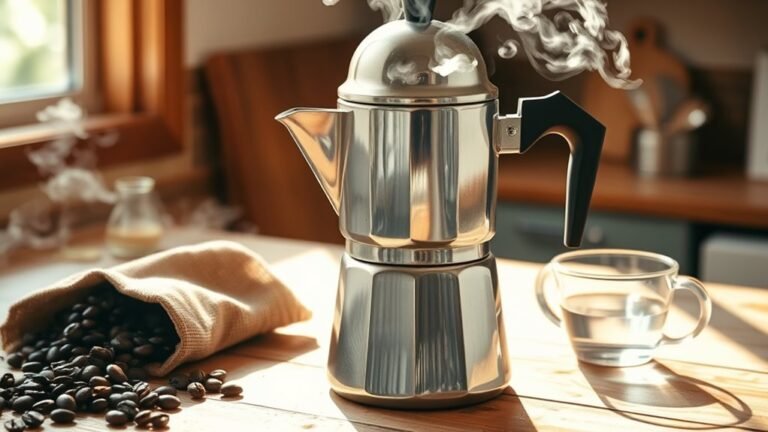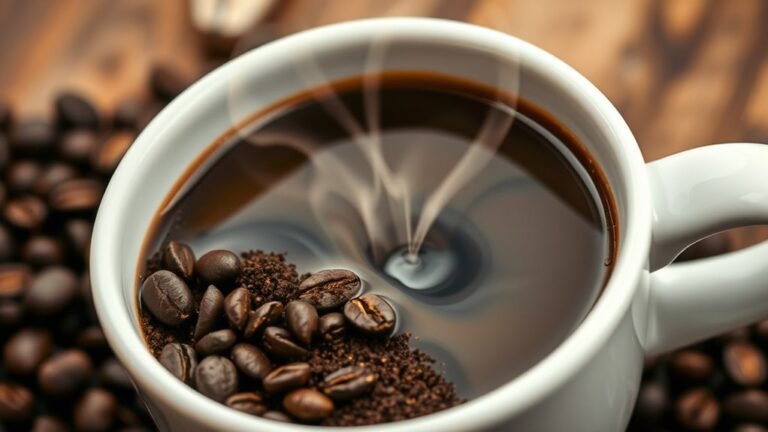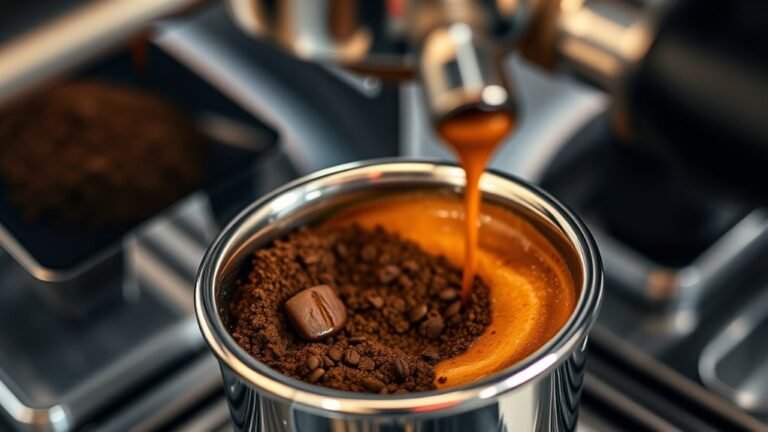How to Make a Great Cup of Coffee Without a Coffee Maker
You can craft a great cup of coffee without a coffee maker by using freshly roasted beans ground to a medium-coarse size and hot water just off the boil, around 195-205°F. Try steeping coarsely ground coffee in a jar with a fine mesh strainer as a French press substitute, or pour hot water slowly over grounds held in a sieve for a pour-over effect. Adjust steeping time to about 3-4 minutes to balance flavor. There’s more to explore for enhancing your home coffee experience.
Essential Tools and Ingredients for Brewing Coffee

Before you begin brewing coffee without a coffee maker, you’ll need to gather a few essential tools and ingredients that guarantee a rich, flavorful cup. Start with thoughtful coffee bean selection—opt for freshly roasted beans suited to your taste, whether bright and acidic or deep and earthy. Quality beans lay the foundation for your brew’s character. Next, consider your grinding techniques; a consistent grind size is vital. Depending on your brewing method, adjust your grind from coarse to fine, ensuring best extraction. You’ll also need a reliable grinder—manual or electric—that gives you control over grind uniformity. Finally, have fresh, clean water and a heat source ready. With these essentials, you’re empowered to craft coffee that speaks to your love of freedom and quality, no coffee maker required.
Brewing Coffee With a French Press Alternative
One effective way to brew coffee without a traditional French press is by using a simple jar and a fine mesh strainer. You’ll need to mimic the French press method by steeping coarsely ground coffee in hot water, then pressing the grounds down with the strainer. Attention to coffee ratios is key: a 1:15 coffee-to-water ratio guarantees balanced extraction.
| Step | Action | Tip |
|---|---|---|
| 1 | Add coffee to jar | Use coarse grind |
| 2 | Pour hot water | ~200°F (93°C) |
| 3 | Steep 4 minutes | Cover jar to retain heat |
| 4 | Press grounds with strainer | Pour immediately after |
This DIY French press alternative gives you freedom to enjoy quality coffee anywhere.
How to Make Pour-Over Coffee Without a Dripper
Although you might not have a traditional dripper on hand, you can still achieve a clean, flavorful pour-over coffee by using common household items like a fine mesh sieve or a paper filter set over a mug. Start by selecting a medium-coarse coffee grind to optimize extraction with these improvised tools. Place your paper filter inside the sieve, or use the sieve alone if you prefer, then add the coffee grounds evenly. Slowly pour hot water in a controlled spiral, allowing the water to fully saturate the grounds—this mimics professional pour over techniques. The fine mesh or paper filter will trap most grounds, ensuring clarity in your cup. With a bit of patience and precision, you’ll enjoy a satisfying pour-over experience without needing specialized equipment.
Stovetop Coffee Brewing Methods

Stovetop coffee brewing offers a hands-on approach that delivers rich, robust flavors by allowing you to control every step of the process. Whether you’re using a stovetop espresso maker or a classic coffee percolator, you can craft a cup that suits your taste perfectly. Here’s how you can get started:
- Stovetop espresso: Heat water in the bottom chamber; as it boils, pressure forces water through finely ground coffee, producing a concentrated brew.
- Coffee percolator: Boil water at the base, which cycles through a tube and filters repeatedly over coffee grounds, intensifying flavor.
- Heat management: Control your flame to avoid over-extraction or bitterness, ensuring a balanced, aromatic cup.
Mastering these methods gives you the freedom to enjoy café-quality coffee without any electric machines.
Tips for Enhancing Flavor Without a Coffee Maker
After mastering stovetop brewing techniques, you can further elevate your coffee’s flavor by paying close attention to grind size, water quality, and steeping time. Start with fresh coffee bean selection—opt for beans roasted within the last two weeks for best aroma. Precise water temperature is essential; aim for 195-205°F to extract the perfect balance without bitterness. Adjust steeping time based on grind size to avoid under or over-extraction.
| Aspect | Recommendation | Effect on Flavor |
|---|---|---|
| Coffee Bean Selection | Fresh, medium roast | Balanced, vibrant notes |
| Grind Size | Medium-coarse | Even extraction |
| Water Temperature | 195-205°F | best flavor extraction |
| Steeping Time | 3-4 minutes | Avoids bitterness or sourness |
These tips give you freedom to customize your brew perfectly every time.
Frequently Asked Questions
Can I Use Cold Water Instead of Hot for Brewing Coffee?
You can absolutely use cold water for brewing coffee, but it’s a different process called cold brew. Unlike hot brewing, cold brew uses room temperature or cold water and requires a longer steeping time—usually 12 to 24 hours—to extract flavors properly. So, if you’re after a smooth, less acidic cup, cold water and time are your allies. Just remember, water temperature greatly influences extraction speed and taste.
How Long Should I Grind Coffee Beans for Optimal Flavor?
You’ll want to grind your coffee beans just long enough to achieve a uniform grind consistency, which is key for balanced flavor extraction. Typically, grinding for about 15 to 30 seconds in a burr grinder works well, but it depends on your grinder’s speed. Too coarse, and your coffee will taste weak; too fine, and it might be bitter. Experiment to find your sweet spot, giving you full control over your brew.
What Is the Best Coffee-To-Water Ratio Without a Coffee Maker?
Did you know 92% of coffee drinkers prefer a consistent coffee strength? To nail the best coffee-to-water ratio without a machine, start with 1 to 2 tablespoons of coffee per 6 ounces of water. This balance lets you control strength precisely, adapting your brewing techniques like steeping time or grind size. Embrace this freedom to tweak your brew until it matches your perfect cup every time.
Can I Reuse Coffee Grounds for a Second Brew?
You can reuse coffee grounds for a second brew, but expect a weaker coffee strength and a more muted flavor profile. The initial extraction pulls most of the rich oils and flavors, so the second cup will be lighter and less intense. If you prefer freedom in your brewing, experiment with steeping time to balance taste, but don’t expect the same robust experience as the first brew. It’s a practical option for reducing waste.
How Do I Store Coffee Beans to Keep Them Fresh Longer?
To maintain bean freshness, your coffee storage should be airtight, away from light, heat, and moisture. Use opaque containers with a tight seal, and keep them in a cool, dark place like a pantry. Avoid the fridge or freezer, as condensation can harm the beans. You’ll extend their flavor and aroma, giving you freedom to enjoy rich, fresh coffee anytime without rushing through your stash.






